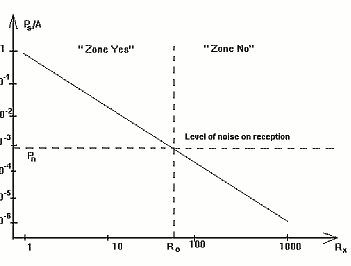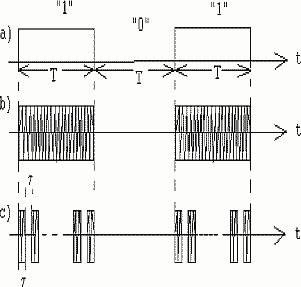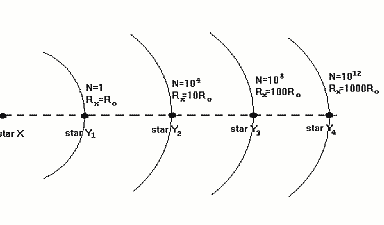A SETI correspondent helps us to discover their signals, lost in the noise of our receivers(A working hypothesis)N.T.PetrovichMoscow Technical University of Telecommunications and Informatics, Moscow, RussiaAstrophysics and Space Science, 1997, vol 252, p. 55-66
It could be that SETI signals have arrived at the Earth, but are lower then
the noise level, and our receivers cannot detect them. We analyze
the situation when a SETI correspondent sends signals that can be accumulated
upon reception, permitting detection of even very weak signals. It is
shown that using this method, we can already transmit SETI signals over
our entire Galaxy.
We have no grounds to exclude the possiblity that SETI signals have safely arrived at the Earth, in spite of its location at the very brink of the Galaxy. However, the levels of these signals may be lower them the total noise level at the input of our receivers. This may be one reason why the intelligent Cosmos is maintaining its silence. Let some civilization X radiate SETI signals of power Ps. If they are sent from a star at a distance Rx, the power of these signals will be (Fig. 1)

Fig. 1
where A is a constant depending on the parameters of the transmitter. Figure 1 also shows the input noise level Pn at the receiver civilization Y that is trying to detect these signals.
Let us denote the critical distance when Ps=Pn,
Rx=R0. In particular,
let us assume that reception of SETI signals is possible when
Rx There is only one SOLE POSSIBILITY for signal reception with signal/noise ratio arbitrarily low. It is necessary to take many measurements $N$ of the mixture of signal and noise, in which the correlation between signals will be higher then the correlation between the noise, and to sum them afterwards. This is a well-known method of accumulating data.

Fig. 2
It is logical to suppose that other civilizations understand this SOLE POSSIBILITY no worse then we do, and very likely already send SETI signals that can be accumulated (Petrovich,(1995a)(1995b)). The simplest of these are signals with long duration (analog or digital). In practice, it is more efficient to use a time factor, since the problem of SETI contact does not limit the duration of the signal element and semantic text. I believe the accumulated SETI signals will be simple. A signal element transmitting "1" may be a sinusoidal oscillation of long or very long duration (analog version), or a long packet of periodic pulses (digital version). A signal element transmitting "0" may be a pause without any signal radiation for the same duration (Fig. 2). Since coherent accumulation with SETI signals is extremely complicated, we will analyze only non-coherent accumulation by a power receiver (radiometer), shown in Fig. 3.

Fig. 3
For the case of a signal deeply immersed in noise (Ps << Pn), the time T for discovery of the signal is approximately [1]
where F is the band filter transmission at the output of a quadratic detector, d2 = ( Ps / Pn)out is the signal/noise ratio at the output of the accumulator, and Pon = Ps/ F is the power noise spectrum. Formula (2) does not suppose any correlation between the noise in N counts. The time T for discovery of the signal by accumulation is equal to
From (2) and (3), we have
where (Pn / Ps)in is the noise/signal ratio in the receiver input. Using (1) and (4) and taking d=1, we find that
It follows that the rise of Rx compared to R0 is
Suppose that the SETI signal is a sinusoidal oscillation of duration T
(Fig. 2b). The noise decorrelation time
thus, the duration of one signal element "1" or "0", is
If the SETI signal is a long packet of periodic pulses (Fig. 2c), the duration of one signal element is
Using (6), (8), and (9), we obtain the values in Table 1, which gives the duration of a single elementary signal transmitting a "1" or "0". It follows from Table 1 that by making the signal element T longer and longer (analog or digital), it is possible to increase the radius of "Zone Yes" Rx by a factor of 10, 100, 1000 ... .

Fig. 4
In Fig. 4, we show civilizations on stars Is it possible to realize accumulation of such signals upon reception without making them as long as shown in Table 1? In principle, it is possible. The first way is to receive the signals using many antennas and to sum them. The number of necessary antennas will be also N (if the summation is incoherent). The second way is to transmit the SETI signals at the same time on many frequencies and receive them by many antennas and receivers tuned to these frequencies. The number of necessary frequencies is also equal to N (if the summation is incoherent). Conclusions
Reference
Petrovich N.T. The problem of radio-contact with different civilization (problem SETI) M. Foreign Electronics 1995b,N2/3 |

